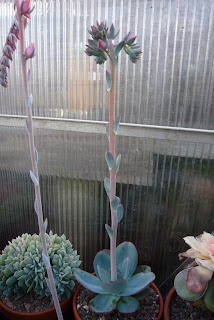It has been a while since the work garden was featured, so it was time for an update.
The shade or fern bed has matured. As the courtyard is in central London it doesn't get cold enough to kill the fronds, so the largest tree fern has built up quite a head of fronds. This has had the unexpected result of stopping rain from getting to the smaller fern and it has suffered.
The people on the first floor love the ferns and there are always comments on how nice it is to sit at the table by the glass window and look directly into the fern. One of the other plants in there that is doing well is the podophyllum kaleidoscope.
The bamboos as always have gone mad, here they were when planted two years ago:
You can see we had plenty of space for a banana as well as summer bedding. Then yesterday.
Finally my favourite part, the rockery. This gets not protection at all over winter and has been a bit of a test ground for plants that don't quite make it for me.
A lot of the plants have survived without any problems at all, the knophofia northiae are getting bigger by the day.
they are starting to swamp the small agave parryi and agave bracteosa
It is no surprise that these have been untouched by the winters, the agave utahensis have been more of a surprise. These are known to be very cold tolerant if dry, but cold and wet is a big no, two of the three have shown no damage at all.
It is proving a good advert for succulents, with everything in flower and the unusual plants, I often get questions form staff about the plants and would would be transferable to their gardens.









































